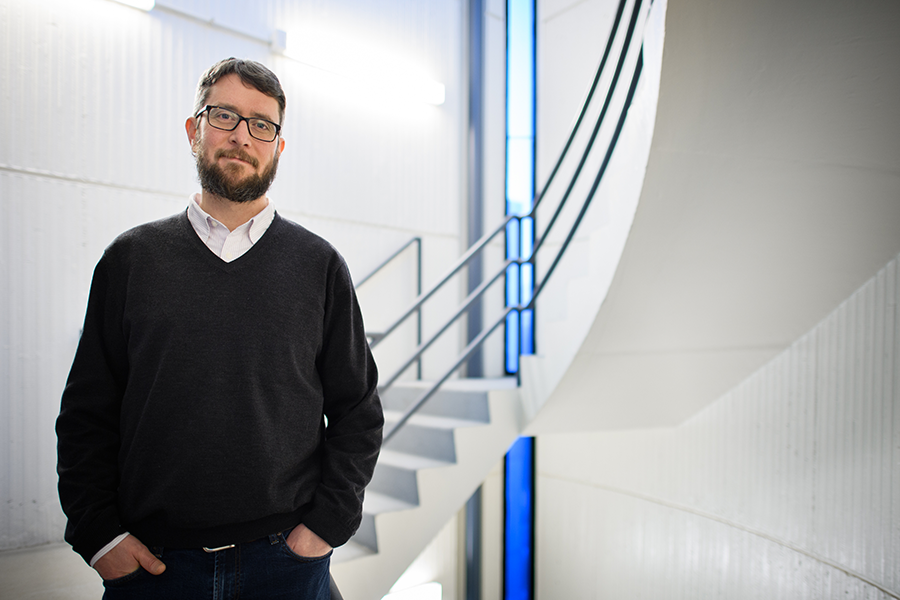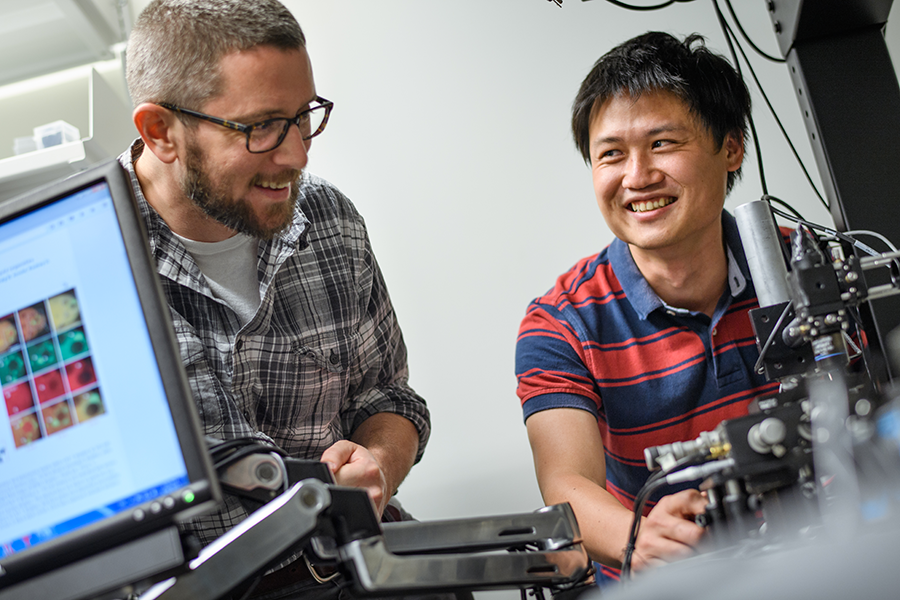MSE alum discovers fundamental advance in understanding of cells
Cliff Brangwynne (MSE ’01) wins the 2023 Breakthrough Prize in Life Sciences for discovering a cellular process with the potential to revolutionize treatments for neurodegenerative diseases like ALS.
A journey that started in the humanities at Carnegie Mellon led alumnus Cliff Brangwynne (MSE ’01) to discover and elucidate a cellular process with the potential to revolutionize treatments for neurodegenerative diseases like ALS, among other clinical applications.
Brangwynne’s discovery—that living cells organize not just through structures defined by membranes but also through liquid-liquid phase separation—was published in Science in 2009. That paper gained traction over the years with more and more scientists recognizing its significance, and this year Brangwynne and co-author Anthony Hyman were awarded a $3 million Breakthrough Prize in Life Sciences, one of the world’s largest science awards.
Often likened to the way oil and water refuse to mix, phase separation had not previously been associated with cell biology, though it is a core concept in materials science and engineering. Brangwynne compares it to water condensing on a cold glass of iced tea on a humid summer day, or rain forming in the atmosphere. In both cases, the water molecules existed in the air as a gas or vapor before undergoing phase transition into a liquid.
But instead of water molecules, Brangwynne discovered biomolecules condensing into liquid-like droplets distinct from the watery buffer that surrounded them inside the cell.
I’ve had a very front row seat in something that has grown much bigger than what any set of individuals can do. And that’s really amazing to see, to watch that grow and evolve.
Cliff Brangwynne, MSE '01
“I am very fortunate to have been able to work with fantastic collaborators to found this new field,” Brangwynne said, referring to his former colleagues at the Max Planck Institute of Molecular Cell Biology and Genetics and his more recent collaborators and trainees at Princeton University. The field has continued to expand as more researchers explore the discovery’s implications in different contexts. “I’ve had a very front row seat in something that has grown much bigger than what any set of individuals can do. And that’s really amazing to see, to watch that grow and evolve.”
According to the Breakthrough Prize announcement, “Their discovery is a fundamental advance in our understanding of cellular organization, and is likely to lead to clinical applications in the future, including for neurodegenerative diseases such as ALS.”
Phil LeDuc, a professor of mechanical engineering and founding director of the Center for the Mechanics and Engineering of Cellular Systems, said Brangwynne “absolutely, totally deserved” the Breakthrough Prize for advancing thought on how cells organize themselves.
A layperson might think of cells as being like a soup filled with a few noodles, “but it’s more like a jungle,” LeDuc said. Despite having such a packed environment, cells can function efficiently with organizational mechanisms including phase separation.
Before Brangwynne’s work, LeDuc said very few people were connecting the two concepts. “He’s defined an area inside of the field that’s super powerful and also has really taken it to some really fantastic levels of thinking,” LeDuc said. He added, “Cliff is an extremely creative person. His creativity is just at such an extremely high level, and that really separates him from so many people.”
A unique path
Brangwynne> grew up in a working-class family full of “plumbers, painters, electricians, and nurses” in the Boston area before becoming a first-generation college student unsure of what to study. Now a professor of chemical and biological engineering at Princeton University and the director of the Princeton Bioengineering Initiative, he said he began questioning the material make-up of living cells as an undergraduate at Carnegie Mellon University.

Source: Princeton University
Cliff Brangwynne (MSE ’01), a professor of chemical and biological engineering at Princeton University, won a 2023 Breakthrough Prize in Life Sciences for his discovery of a cellular process with the potential to revolutionize treatments for neurodegenerative diseases.
He didn’t know he would eventually pursue engineering—as a first-year student, he was vaguely interested in psychology, Spanish, and biology. He decided to take the Introduction to Materials course solely because of an interesting conversation he had as a high schooler with an acquaintance who happened to be a materials science and engineering (MSE) graduate student at MIT. Brangwynne was quickly drawn into the discipline; however, he took an unusual path.
Even while majoring in MSE, he minored in physics and worked in a lab conducting biology research under Associate Professor Fred Lanni at the Mellon Institute during his second semester and the following summer. Brangwynne decided to take a year off of college after his sophomore year and ended up spending much of that time working in a Harvard lab that grew his interest in cells.
At first, Brangwynne’s MSE coursework didn’t seem to have any connections with the biology research he was conducting. He said in many ways his career has been about trying to bridge the two disciplines, and “it all started at Carnegie Mellon.”
“I’m pretty excited about seeing the intersection of those two areas—the thinking about materials and the science and physics and engineering in materials, and living cells and living materials,” Brangwynne said.
He encourages Carnegie Mellon students to seek their own paths. “I think you have to be a little bit bold and brave maybe, and follow your heart and your interests even if they don’t necessarily make perfect sense to everyone else,” he said.
Making an impact
Brangwynne hopes his research will have a broader impact than its direct findings would suggest, by encouraging other people to explore new connections across disciplines.

Source: Sameer Khan, Fotobuddy/Princeton University
Clifford Brangwynne (MSE ’01) and Ming Tzo Wei, then a post-doctoral researcher at Princeton University, work together in a lab.
As for the Breakthrough Prize, Brangwynne said he was “incredibly honored and humbled” to receive it. One of the best things about such recognition is that it raises the profile of science, he said.
“People get excited and inspired by what can be done in science and engineering. And I’m really excited and very happy to play my part in that because it’s important,” he said.
LeDuc said Brangwynne’s impact goes beyond the science. The two first met at Harvard where LeDuc was a postdoc at the same time Brangwynne took his gap year to work in the lab.
“There is something beautiful when a scientist of this extremely high talent level is also a wonderful person,” LeDuc said. “Particularly to me at Carnegie Mellon where we tremendously, highly value people, as well as their science, that makes him a wonderful alumnus. He can do the science at an extremely high level, but he also affects lots of people in a very positive way. He’s a very positive, uplifting person.”
Pictured, top: Cliff Brangwynne (MSE ’01), a professor of chemical and biological engineering at Princeton University, works with a student in a Princeton lab.
